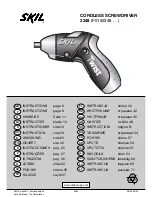
35
5. SAFETY INSTRUCTIONS
1.
This equipment, if improperly used, can cause physical and material damage. To avoid these damages,
follow the instructions below:
• This equipment may not be used by people with physical, sensorial, or mental handicaps, or without expe-
rience or knowledge of use.
• People without the proper experience or knowledge may use this equipment only if properly supervised and
instructed to it’s use by someone who is liable for his or her safety.
• This equipment may not be used by children under any circumstances.
• Do not use your equipment while tired, under the infl uence of medication, alcohol or drugs. Lack of attention
during operation may result in serious personal injury;
• This equipment can cause mechanical or electrical interference on nearby sensitive equipments;
• Must be installed and operated in places that are ventilated and protected against moist presence and water
falling, and must not operate in places where unauthorized people, children or animals can have access to.
2.
Always use suitable personal protective equipment (PPE), such as
s glasses, gloves, hair protection,
safety shoes, etc.
3.
While in use, this equipment has electrical components,
cutting parts
and moving parts;
4.
The equipment
has a device that interrupts the operation of the machine when removed from the start
switch.
5.
To reduce the risk of electrical shock:
• For protection against electric shock, it is recommended to install a residual current circuit breaker. Consult
an electrician to select and install this safety device;
• Do not use the equipment b
arefoot, in wet or very humid places, do not touch metal surfaces such as pipes,
motors, gutters, fences, windows, doors, metal gates, etc, this increases the risk of electric shock;
• Before cleaning or performing maintenance, disconnect the machine from the electrical network;
• Never use extension cords that don’t meet the specifications (see INSTALLATION chapter), they must not bear
splices. The non-compliance with these instructions might compromise the operation of the drill: voltage
drop, power loss, overheating and injuries to the user.
• Power outlet must be compatible to the tool plug. To reduce the risk of shock, do not change the plug charac-
teristics and do not use adapters. If required, replace the outlet with a plug suitable model.
• Do not use your electric equipment in explosive atmospheres (gas, liquid or dust). The motor generate
sparks that may cause explosion;
• Make sure the power trigger is in the “off” position before connecting the equipment to the power
grid.
6.
Never operate the drill without its belt guard or with the belt guard open.
7.
When changing the speed (pulley/belt), never ask for anyone’s help, because it can cause accidents.
8.
Never use drill bits with diameters superior to the ones specified in the Technical Data table, and respect the
specifications for the material to be drilled (see
INSTALLATION chapter).
9.
Do not alter the diameter of the moving pulley, because it comes from the factory in conformity with the
speed, according to the specifications on the identification plate.
10.
Never operate the drill with drill bits that are dull or badly preserved.
11.
Never start drilling a workpiece without certifying that it’s properly fixed to the table or drill base.
To avoid
accidents, always fasten the part properly/accessory before starting work. If required, use clamps.
12.
Never exceed the speed specifications in INSTALLATION chapter’s Tables.
13.
Do not perform maintenance with the drill turned on, as a safety measure, turn off the start switch and
unplug the equipment from the power outlet.
14.
Do not clean or work on the electrical components without unplugging the equipment from the power
outlet first.
Summary of Contents for FSB 16 TORK
Page 2: ......














































